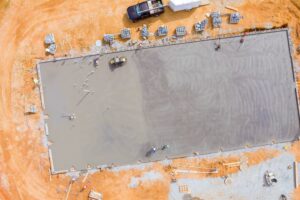Why Concrete is Still the Most Important Composite Material in Construction
Concrete has been the most widely used composite material in construction for centuries. Used in structures from The Pantheon in Rome to modern skyscrapers and roads, concrete’s versatility and strength have made it a staple in construction.
But what exactly makes it so essential? It’s a composite material that provides superior durability to projects compared to other similar materials. You might ask “why is concrete a composite material”? Because it’s a blend of aggregates, cement and water.
This mix gives it unique properties. It allows concrete to handle overwhelming amounts of pressure and withstand harsh conditions, including heat, cold, and moisture. This makes concrete aggregates ideal for creating foundational structures to support heavy loads.
In this blog post, we’ll break down the importance of concrete and why it has been the most dominant composite material in construction for centuries.
The Composition of Concrete
Typically, concrete consists of approximately 10-15% cement, 60-75% aggregates, and 15-20% water. When water is added, a chemical reaction called hydration occurs, which forms a paste that clumps the aggregates together. This results in a hardened, solid material that can stand the test of time.
The durability and effectiveness of the finished product all come down to the ratio of materials used, which can significantly affect your concrete aggregates’ strength. Too much water can weaken the concrete, while a lack of cement can cause it to crumble. Maintaining the right balance is key to guaranteeing its durability and resistance.
Different projects need different concrete mixes, so you’ll need to create your mix based on what the project demands. A higher cement ratio creates a stronger and heavier concrete, while more sand results in a smoother texture.
This different use potential is part of why concrete is such an important composite material in construction. It offers a level of versatility that most alternatives often can’t. You can tweak and adjust its composition to make it suitable for almost any application.
The Importance of Concrete in Construction
There’s a good reason why concrete has been the go-to composite material for builders over the centuries. Here’s why it’s an essential part of any construction or landscaping project:
1. Durability & Reliability
Concrete lasts for decades and even centuries, in some cases. It doesn’t rust and holds up structures with minimal maintenance. It’s designed to withstand heavy loads and harsh weather conditions without affecting the overall build.
2. Cost-Effectiveness
Concrete is produced in vast quantities due to its high demand throughout the world. It’s widely available at cheap prices compared to steel, wood, or other composite materials. It’s easy to source and is a great foundational option for a variety of construction or landscaping projects.
3. Fire & Weather Resistant
The components of concrete are non-combustible, making it highly fire-resistant. Plus, it can handle moisture, heat, and cold reliably, keeping your structures stable. This also helps ensure your structures meet safety compliance standards in the construction industry.
4. Sustainability Potential
While concrete itself isn’t a sustainable material, it can still be green. You can make it using recycled materials, such as crushed aggregates, so you’re creating a more sustainable option for construction. These blends preserve the environment by cutting down on landfill waste.
Challenges & Innovation
Despite being such a widely used composite material in construction, concrete comes with its own set of challenges. For starters, as we briefly mentioned above, concrete itself isn’t an environmentally friendly material. It uses cement, which emits a lot of CO2 in production.
Cracking is another issue with concrete. In most cases, given enough time, concrete will inevitably start cracking. As it dries, concrete starts to shrink and can potentially change its structure if not properly designed and constructed.
The good news is that solutions are emerging for these challenges.
On the other hand, using recycled aggregates and low-carbon cement for concrete production significantly reduces its environmental impact. Self-healing concrete is another evolving concept that helps fix cracking. It’s a bacteria-based concrete that produces limestone to fill the cracks as they appear.
Concrete is undoubtedly going to continue evolving to become a more sustainable and durable composite material. That’s a big reason why it has stayed relevant for so long.
Contact Middleton Aggregates for High-Quality Concrete Aggregates
Concrete has stood the test of time with its durability and reliability. It remains an essential composite material in construction for a variety of applications.
That said, not all concrete is created equally. The quality of the concrete aggregates can significantly affect your end result. That’s why you need a reliable supplier to provide you with the best quality concrete aggregates.
At Middleton Aggregates, we supply a wide range of durable aggregates and fill materials for various construction and landscaping projects. We also offer a plant hire service to meet all your construction needs.
Operating from Blackborough End, King’s Lynn, we serve Norfolk, Suffolk, Lincolnshire, Cambridgeshire, and the wider UK. For any questions you may have, our team of industry experts is always available to provide you with the best advice.
For more information on our products and services, visit our website or contact us to find out more.
